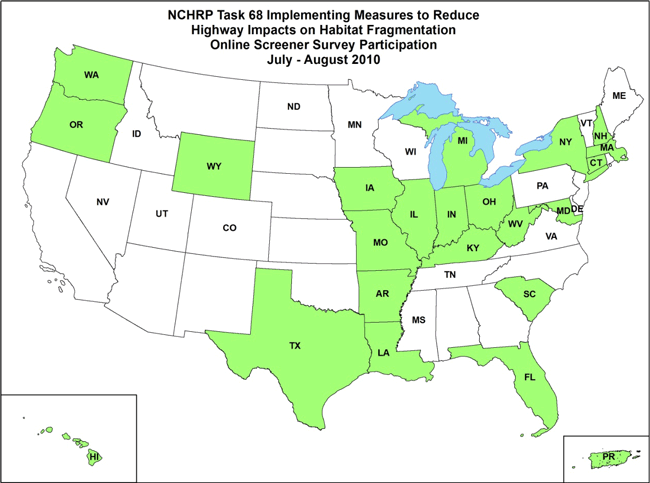B. Screener Survey for Habitat Fragmentation Avoidance and Compensation, continued
2. Results Summary
The results of the online screener survey indicate that the 71% of the 24 states that completed the online survey do incorporate the State Wildlife Action Plan (SWAP), and/or consider natural resource protection, wildlife and/or stream corridors or critical habitat for threatened and endangered species in their statewide or regional transportation planning processes. However, 50% of the planning processes do not contain written objectives such as "maintain habitat connectivity" or "minimize habitat fragmentation". Fifty-eight percent of the states responding have both mechanisms in place to proactively address connectivity rather than reactively mitigate as well as have priority areas for habitat protection/connectivity and/or have state or regional habitat connectivity plans. Sixty-seven percent of states have critical habitat mapping, terrestrial and aquatic wildlife corridors, and/or other information readily available during the transportation planning process.
Figure 1 - Online Screener Survey Participation: July-August 2010
Twelve of the states responding confirmed that their state has adopted mitigation strategies for impacts due to habitat fragmentation and loss of connectivity for projects. Those twelve states then indicated that the predominant forms of mitigation that took place were preservation, enhancement and restoration. Nine of these states approximated that there were less than 10 projects that used mitigation for habitat fragmentation in the last ten years.
When considering mitigation for habitat fragmentation and loss of connectivity of habitats, 75% of the states responding said that potential mitigation sites are weighted differently based on connectivity to adjacent habitats. Additionally, 75% of states indicated that regulatory agencies do require post-construction monitoring of compensation mitigation to determine if they are effective or meeting performance goals.
Three quarters of the states that took the online survey volunteered to participate in a telephone interview to examine their Avoidance & Compensation techniques more in-depth. Taking into consideration affirmative answers provided as well as geographical diversity, the following DOTs from seven states and the Commonwealth of Puerto Rico were pursued for Avoidance & Compensation interviews:
- Oregon
- Arkansas
- Indiana
- New York
- New Hampshire
- Maryland
- Puerto Rico
- Hawaii
